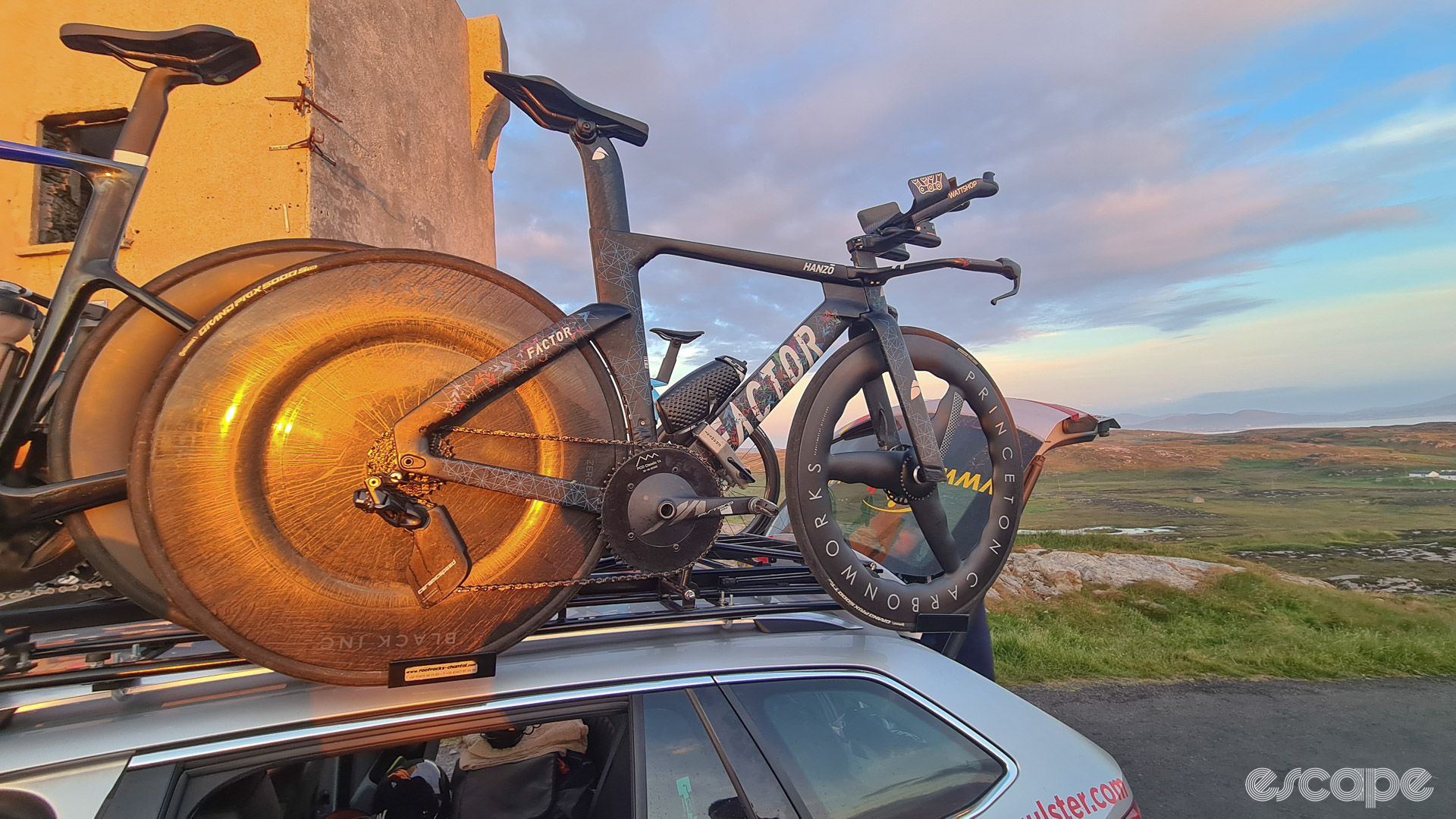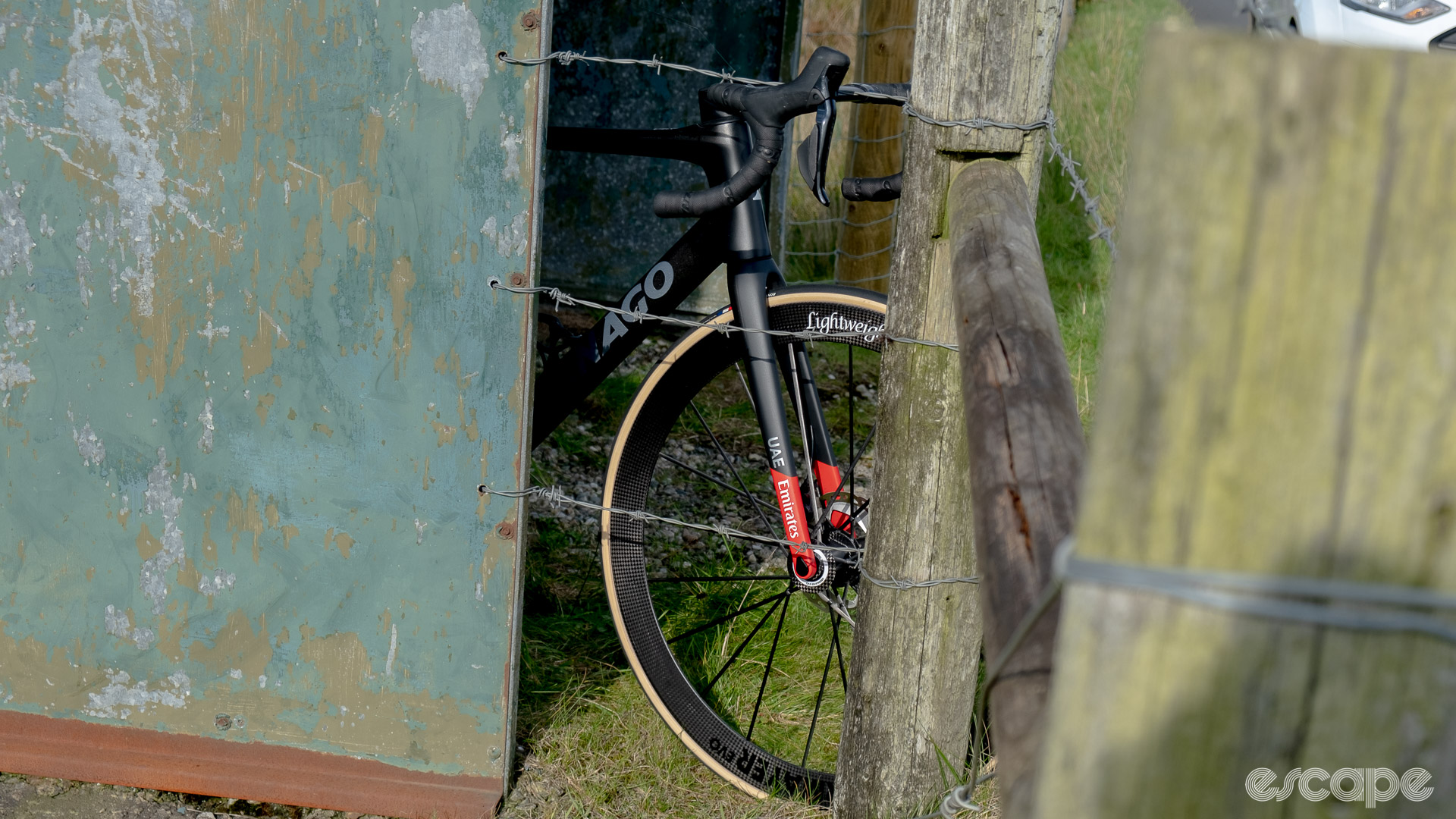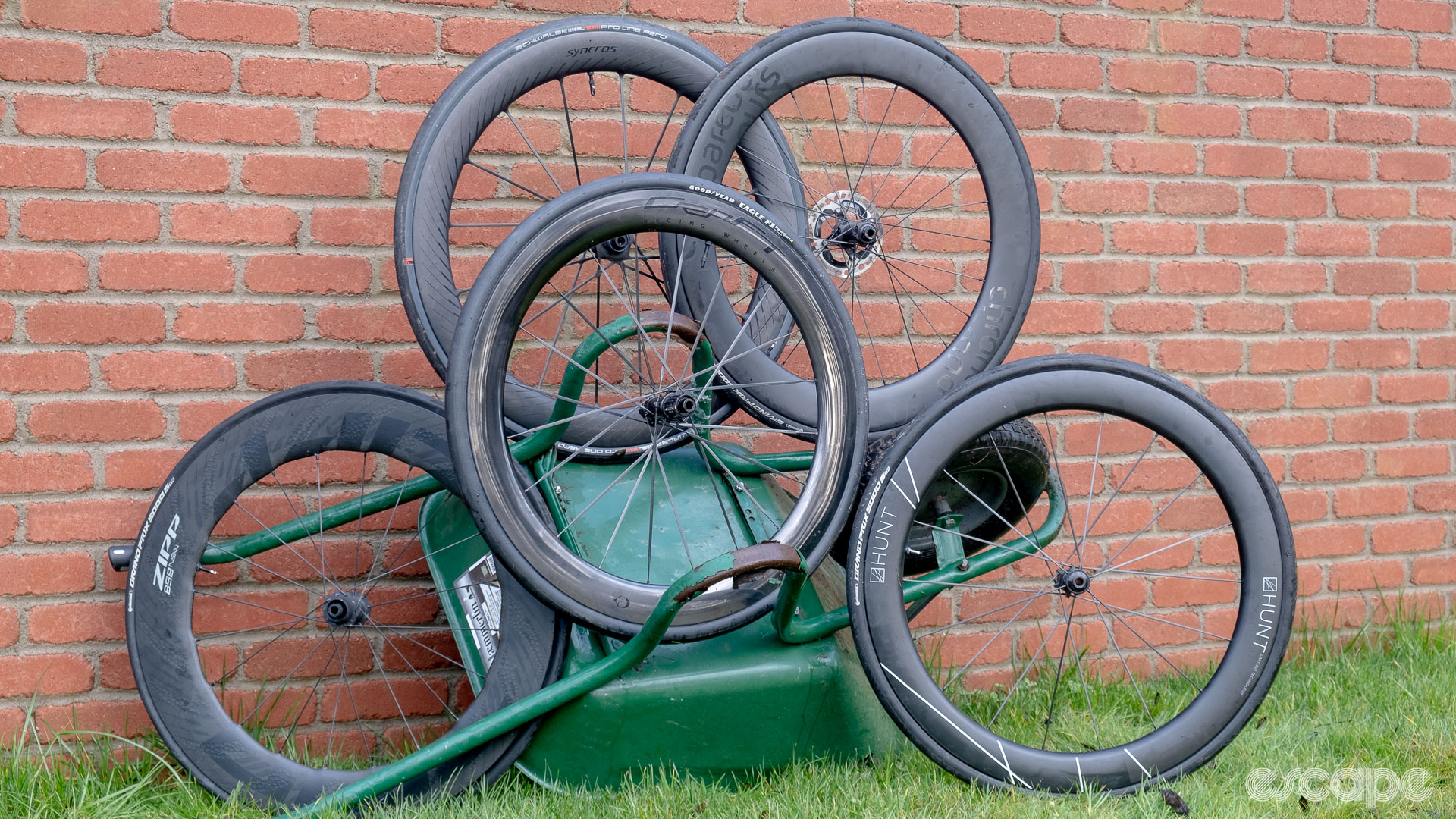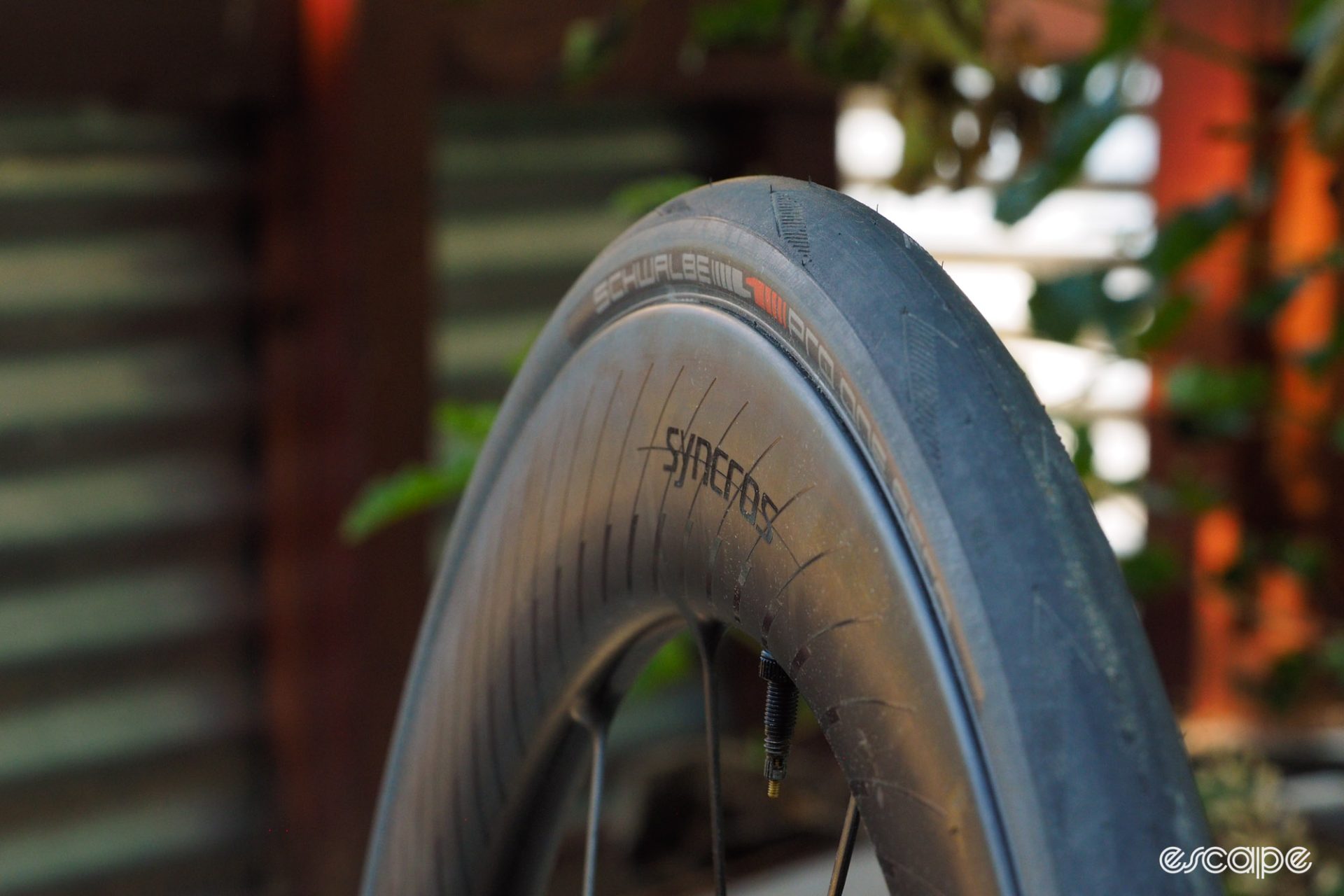Forget your freehub; there's no better bike sound than that whoosh-whoosh-whoosh-whoosh sound deep-profile carbon wheels make, especially when accelerating out of the saddle. Disc wheels are even better, i.e. louder. But why do carbon wheels make this noise, and is it just our imagination, or is that whoosh sound notable by its absence in many modern wheels?
Why are some carbon wheels loud when rolling and some are not? That was the question Escape Collective member Mark Huie posed in Escape's Discord "Tech-General" channel (think online forum without the BS). It's a seemingly simple question, but take a second to ponder it, and if you are anything like me and others on the Discord channel, it sucks you in like a deep rabbit hole.
It's "aero/turbulence noise," it's resonance, it's both, and undamped flex, the answers pinged back. Ok, but in the words of my five-year-old daughter … "why?" Is it something to do with rim depth? What about carbon layups or internals?
I like to encourage my daughter's "but why" questions and try not to (sometimes failing) answer "just because," and of course we love members' questions also. As such, I emailed the question to Silca CEO Josh Poertner, a true aero geek with vast experience in the wheel industry from his time at Zipp. If anyone knows the actual cause of the whoosh-whoosh sound and why it's seemingly absent in some deep profile rims, it would surely be Josh.
The answer is both simple and straightforward. Firstly, that whoosh noise, that's resonance, but "it's affected pretty dramatically by construction methods, materials, and cavity volume," Poertner tells us.
According to Wikipedia, "resonance is a phenomenon in which an acoustic system amplifies sound waves whose frequency matches one of its own natural frequencies of vibration," but as Poertner explains, within that "there is what's called the resonance frequency which is the frequency where the amplitudes will be highest. "
In simpler terms, you have something that can vibrate, like a string or surface that is either rigid or in tension, and you have some volume of air that can be moved to push the sound waves. Excite the string or surface, and it makes a noise. Simple!
Ok, that makes sense, but why are deep rims louder? Well, according to Poertner, size matters: "The length and surface area of the resonance surface is critical," he explains, offering a drum as an example, "if you shrink a drumhead down to the size of a quarter and hit it, you won't get much noise, but with a bigger drum you'll get much more."
Basically, the more surface area a rim or wheel has, the louder it can potentially be, hence why time trial disc wheels are loudest, then deep rims, and so on. As Poertner explains, "Once a rim gets below about 40mm, there's just not enough sidewall to really move much air, not to mention the natural frequency will be extremely high such that the amplitude and therefore the sound potential is very low," answering the question why the sound is only associated with deeper rims and solid wheels.

But it's not just size; construction also matters, specifically, tension in the sidewall or disc wheel skins. Poertner tells us that structural and tensioned skin disc wheels (hollow without spokes inside) such as Campagnolo Ghibli, Lightweight Autobahn, or the Black Inc Zero will be the loudest thanks to their large surface area of tensioned carbon. Just like a drum, or as Poertner explains, there is a "large resonance surface with low natural frequency (and therefore high amplitude potential) that is very easy to excite through ground vibration inputs, and once excited, the wheel acts like a drum, moving air both inside and outside to make noise."
Compare that with something like the older HED disc wheels, which had a thin foam core behind the carbon face; that foam core provided plenty of damping, so although the old HED and aforementioned new wheels are both hollow and lenticular, they sound very different. Poertner also cites the Zipp disc as a halfway house "as it has a Nomex core that adds some damping, but with skins, just a few thousandths of an inch thick, plus the system has some tension in it. As such, the wheel can be quite loud in some situations but doesn't have that ongoing resonance of a hollow tension disc."
Ok, so discs are loud, that much we know, but what about typical spoked wheels and the quieter modern wheels? Poertner gives a few examples as comparisons of different construction techniques, answering the hows and whys of deep rim noise.

He points first to the rims like the original Zipp 808, a completely hollow rim with full toroidal sides and thin sidewalls. It was "quite loud as road inputs are constantly exciting those curved sidewalls, which in turn can move a decent amount of air," even compared to "something like the Lightweight or Corima wheels, which use an ultralight and stiff Rohacell foam core with a very high damping coefficient. Those wheels are much quieter thanks to the foam core, which damps the sidewalls, preventing them from resonating."
Ok, but what about the carbon and or the layups used? Does that make a difference? Well, yes, according to Poertner, who explains that "higher-end wheels generally used higher ply counts of much thinner materials with higher fibre/resin ratios, which results in lighter, thinner, more resonant sidewalls, which of course will be easier to excite."
Are new wheels really quieter?

Well, kind of, or as Poertner often says on his Marginal Gains Podcast … "it depends." Carbon rim brake wheels require resins rated to higher temperatures to resist heat build-up during braking. Fast forward to today and with the shift to disc brakes, that temperature resistance is no longer required, or at least not to the same extent. As such, manufacturers can now use low-temperature resins toughened with rubber or elastomer additives, Poertner explains, significantly increasing the damping coefficient of the resin itself. And, as you've probably guessed by now: increased damping equals reduced noise.
As Poertner points out, you can effectively see this resin change with the naked eye. As a rule of thumb, high strength and high-temp resins (in cycling terms; even the highest-temperature cycling resins would be considered low temperature in contexts like aerospace) tend to be very clear in appearance, and the carbon looks shimmery and pretty. In contrast, says Poertner, the "toughened resins are milky in appearance and tend to make the carbon look sort of flattish and dark grey," or in other words, exactly how many wheels look these days.
It's at this point that Poertner drops us a bit of an industry secret, explaining: "Almost all of the lower-cost wheels on the market today are designed to hold more resin and are using quite a lot of fibreglass." In doing so, manufacturers can significantly reduce costs while simultaneously making the rim extremely tough with high-impact resistance. Sounds great, and it is, but the "cost," so to speak, is increased weight and reduced stiffness. Remember: "cheap, light, stiff; pick two."
More importantly for this topic, though, the additional resin and fibreglass will also considerably damp any noise, because, according to Poertner, "the fibreglass is much less stiff than carbon and increased resin percentage, especially when the resin is toughened, just adds more damping."
It's a fascinating addition to the conversation and has me wondering if that whoosh-whoosh noise might prove some sort of proxy measurement or acid test for rim quality or market standing. Poertner suggests this may be true for shallower rims but points again to the likes of Lightweight with the foam-filled core, which are both exceptionally pricey and quiet.
Graham Shrive, director of engineering at Factor and Black Inc, told us modern low-to-mid-tier carbon frames (especially heavier options) with much greater wall thicknesses may also damp the sound emanating from our wheels and suggests auditory signals may well reflect ride quality.
Extending on Poertner's drum analogy, Shrive explains, "a thicker drum skin has a deeper tone. That's because the range of frequencies transmitted through the structure increases as the walls get thinner." On the road, the thicker walls in frames and wheels reduce the number of higher-frequency signals. "This is strongly correlated with the perception of comfort, which is broken into frequency transmission and amplitude," Shrive explains, further pointing out that some riders prefer or perceive high frequencies as a "lively" feeling bike where they can feel or perceive the road surface changes directly. In contrast, others try to insulate themselves from those higher frequencies through thicker bar tape, bigger tires, gloves, padded saddles, thicker socks, etc."

"Clinchers and tubeless will never be as loud as tubulars were."
Josh Poertner, Silca
All that said, Poertner explains there is one big difference that explains the quieter wheels of today, and that is … tubeless tyres. As Poertner points out, "tubular rims were essentially one big open cavity, the 808 tubular had probably 75mm of thin sidewall to excite and the same rim in clincher/tubeless has more like 60mm of excitable sidewall."
Furthermore, Shrive added, "Clinchers, specifically tubeless, make a huge difference compared to tubulars because they exert an inverse radial force on the rim when inflated, also changing both the K value (spring rate) of the system and the natural frequency, as well as adding significant damping due to mass under the bead hook, in a tube etc."
Yes folks, for all the possible causes of louder and quieter wheels, we have somehow found ourselves back in the disc brakes and tubeless tyres debate.
Did we do a good job with this story?




